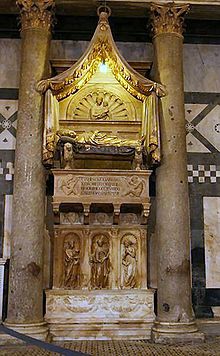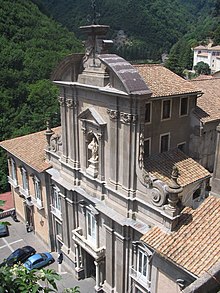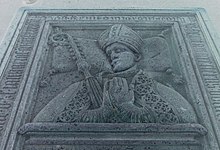An antipope is a historical papal claimant not recognized as legitimate by the Catholic Church. Unlike papal tombs, the tombs of antipopes have generally not been preserved, with a few notable exceptions.










Several tombs of antipopes were desecrated and destroyed, often by their rival claimants, shortly after their creation.[1] For example, Pope Innocent II razed Santa Maria in Trastevere (one of the main Marian basilicas and one of the oldest churches of Rome) to the ground and was eventually buried over the spot once occupied by the tomb of his rival, Pope Anacletus II.[2] Others survived centuries, only to be destroyed during conflicts such as the French Revolution and the War of the Spanish Succession, a fate common to some non-extant papal tombs.[3][4] Such was the case with the tomb of Antipope Felix V (the last historical antipope), who was buried with most of his predecessors as Count of Savoy in Hautecombe Abbey.[5]
Others are obscure because of the damnatio memoriae surrounding the lives of antipopes,[6] or because they were refused burial due to excommunication.[1][7] Some of those can be presumed to have been buried unceremoniously in the monasteries to which the antipopes were confined after submitting or losing power.[1] The exception is Hippolytus of Rome, the first antipope, who was translated to Rome by his former rival Pope Fabian following his martyrdom, and is regarded as a saint.[8]
Various antipopes, however, received prominent burials, including one among the papal tombs in Old St. Peter's Basilica (which were destroyed during the sixteenth/seventeenth century demolition).[9] In particular, the conciliar claimants of the Western Schism were entombed in elaborate tombs in important churches by famous sculptors. The tomb of Antipope John XXIII typifies political iconography of antipapal burial, subtly arguing for the legitimacy of the entombed.[10]
| Pontificate | Common English name | Sculptor | Location | Notes |
|---|---|---|---|---|
| 217–235 | Hippolytus Saint Hippolytus |
Unknown | Cemetery of Hippolytus | Remains translated to Rome by his rival Pope Fabian; inscription by Pope Damasus I recorded in Orazio Marucchi's Christian Epigraphy[8] |
| 251–258 | Novatian | Unknown | Unknown | Tombstone discovered in 1932 on the Via Tiburtina in Rome with the inscription "blessed martyr Novation"; considered unverified by scholars because the inscription lacks the word "bishop"[11] |
| 355–365 | Felix II Saint Felix |
Unknown | Church on Via Aurelia | Martyred and sainted; buried in a church of his making on the Via Aurelia according to Liber Pontificalis[12] |
| 366–367 | Ursicinus | Unknown | Gaul | [12] |
| 418–419 | Eulalius | Unknown | Unknown | Nothing known of death but year[13] |
| 498–499 | Laurentius | Unknown | Unknown | Died on the farm of his patron Festus[14] |
| 530 | Dioscorus | Unknown | Unknown | Memory was officially condemned by Pope Boniface II but reinstated by Pope Agapetus I[6] |
| 687 | Theodore | Unknown | Unknown | Nothing known of him after his concession to Pope Sergius I[15] |
| 687 | Paschal | Unknown | Unknown | Imprisoned in an unknown monastery until his death and buried in an unknown location[15] |
| 766–768 | Constantine II | Unknown | Unknown | Died in an unknown monastery after much corporal mortification at the hands of the followers of Pope Stephen III[16] |
| 768 | Philip | Unknown | Unknown | No historical references after his return to his Monastery of St. Vito (Rome)[16] |
| 844 | John VIII | Unknown | Unknown | Nothing more known after he was confined to a monastery[17] |
| 855 | Anastasius | Unknown | Unknown | [18] |
| 903–904 | Christopher | Unknown | Old St. Peter's Basilica | Interred in Old St. Peter's by his overthrower, Pope Sergius III; destroyed in the seventeenth century demolition of Old St. Peter's; fragment of epitaph recorded by Peter Mallius[9] |
| 984–985 | Boniface VII | Unknown | Unknown | Roman mob seized his corpse, stripped him of his vestments, dragged him through the streets, and deposited it at the feet of a statue of Marcus Aurelius on horseback, at which point he was trampled and stabbed; carried away by clerics at night and buried in an unknown location[19] |
| 997–998 | John XVI | Unknown | Unknown | Bodily mutilated by Pope Gregory V and Otto III, Holy Roman Emperor and confined to a Roman monastery until his death[20] |
| 1012 | Gregory VI | Unknown | Hamburg, Germany | Died in Hamburg; no documentation of funeral or monument exist[21] |
| 1058–1059 | Benedict X | Unknown | Sant'Agnese in Agone | Sarcophagus in the crypt (not open to public) still contains his corpse[22] |
| 1061–1064 | Honorius II | Unknown | Unknown | Died in Parma[22] |
| 1080 | Clement III | Unknown | Unknown | Died in Civita Castellana[23] |
| 1100–1101 | Theodoric | Unknown | Cava de' Tirreni | Died at La Trinità della Cava but buried in the local cemetery; tombstone contains the words "Theodoric, 1102"[24] |
| 1101 | Adalbert | Unknown | Benedictine Abbey of San Lorenzo (Aversa) | [24] |
| 1105–1111 | Sylvester IV | Unknown | Unknown | Died under the care of his patron, Count Werner of Ancona; nothing of death or burial known[24] |
| 1118–1121 | Gregory VIII | Unknown | Unknown | Imprisoned in many places; last known to have been kept in Cava de' Tirreni, but it is unknown if he died there[24] |
| 1124 | Celestine II | Unknown | Unknown | Not an antipope sensu stricto, because his election was legitimate; he was forced to resign a papacy a day after and subsequently submitted to the Pope Honorius II, who was elected in his place.[25] Died from beating inflicted during the election.[26] |
| 1130–1138 | Anacletus II | Unknown | Santa Maria in Trastevere | Destroyed by Pope Innocent II along with much of the church; Innocent II arranged for his own burial, in the rebuilt church, on the site of his former rivals'[2][27] |
| 1138 | Victor IV | Unknown | Unknown (perhaps priorate of S. Eusebio in Fontanella[28]) |
Nothing known of his biography after his resignation[2] |
| 1159–1164 | Victor IV | Unknown | Monastery in Lucca | The clergy of the Lucca Cathedral and San Frediano would not allow him buried there because of his excommunication; tomb destroyed by Pope Gregory VIII in December 1187[1] |
| 1164–1168 | Paschal III | Unknown | Unknown | Died in Castel Sant'Angelo[1] |
| 1168–1178 | Callixtus III | Unknown | Unknown | Died in Benevento[1] |
| 1179–1180 | Innocent III | Unknown | La Trinità della Cava (Cava de' Tirreni) | [1] |
| 1328–1330 | Nicholas V | Unknown | Avignon | Died in the Church of the Franciscans, Avignon[29] |
| 1378–1394 | Clement VII | Perrin Morel | Musée du Petit Palais, Avignon | Original canopied tomb in the Avignon Cathedral moved on September 8, 1401, to the chapel of the Celestines, and in 1658 to the choir of the church; almost completely destroyed during the French Revolution, only the head of the effigy remains[3] |
| 1394–1417 | Benedict XIII | Unknown | Castle of Illueca, Spain | Originally buried in the chapel crypt in Peñíscola; translated to Illueca, Spain and mummified under glass, attracting pilgrims; smashed by an Italian prelate Porro in 1537, after which the room was sealed by the archbishop of Saragossa; destroyed and desecrated by the French during the War of the Spanish Succession; skull recovered and put on display at the castle; buried in the palace of the Counts of Argillo y Morata at Sabinan in 1936 during the Spanish Civil War; skull stolen on August 23, 2000 by two brothers, who sent ransom notes to the Mayor of Illueca, Javier Vicente Inez; Spanish police recovered the skull and returned it to the Castle at Illueca on September 3, 2000[4] |
| 1409–1410 | Alexander V | Niccolò di Piero Lamberti and Sperandio Savelli | San Francesco (Bologna) | Wall tomb[30] |
| 1410–1415 | John XXIII | Donatello and Michelozzo | Florence Baptistry | See Tomb of Antipope John XXIII |
| 1423–1429 | Clement VIII | Unknown | La Seu (Mallorca) | Buried in the Cappella de la Piedad in the Cathedral of Palma, Spain[7] |
| 1424–1429 | Benedict XIV | None | Under a rock in Armagnac, France | Refused burial in a church because of his excommunication[7] |
| 1430–1437 | Benedict XIV | Unknown | Unknown | Died imprisoned in Château de Foix[7] |
| 1439–1449 | Felix V Amadeus VIII, Count of Savoy |
Unknown | Hautecombe Abbey (Ripaille, France) | Destroyed during the French Revolution; name listed on an extant memorial plaque that commemorates him and the other Counts of Savoy, whose tombs were also destroyed in the same Abbey[5] |
Notes
edit- ^ a b c d e f g Reardon, 2004, p. 95.
- ^ a b c Reardon, 2004, p. 92.
- ^ a b Reardon, 2004, p. 138.
- ^ a b Reardon, 2004, pp. 140–141.
- ^ a b Reardon, 2004, p. 153.
- ^ a b Reardon, 2004, p. 43.
- ^ a b c d Reardon, 2004, p. 150.
- ^ a b Reardon, 2004, p. 27.
- ^ a b Reardon, 2004, p. 69.
- ^ Lightbown, R.W. 1980. Donatello & Michelozzo. London: Harvey Miller. ISBN 0-905203-22-4. p. 16l; Caplow, Harriet McNeal. 1977. Michelozzo. New York: Garland Publishing, Inc. ISBN 978-0-8240-2678-3. p. 107.
- ^ Reardon, 2004, p. 29.
- ^ a b Reardon, 2004, p. 37.
- ^ Reardon, 2004, p. 39.
- ^ Reardon, 2004, p. 42.
- ^ a b Reardon, 2004, p. 56.
- ^ a b Reardon, 2004, p. 59.
- ^ Reardon, 2004, p. 62.
- ^ Reardon, 2004, p. 64.
- ^ Reardon, 2004, p. 75.
- ^ Reardon, 2004, pp. 76–77.
- ^ Reardon, 2004, p. 81.
- ^ a b Reardon, 2004, p. 85.
- ^ Reardon, 2004, p. 87.
- ^ a b c d Reardon, 2004, p. 89.
- ^ I. S. Robinson, The Papacy. Continuity and innovation, Cambridge University Press 1990, p. 66
- ^ Reardon, 2004, p. 90.
- ^ Prinz, Joachim. 1966. Popes of the Ghetto. Horizon. p. 237.
- ^ Miranda, S. 1998. "The Cardinals of the Holy Roman Church: Biographical Dictionary: Pope Callistus II (1119–1124): Consistory of December 1122 (VII)". Florida International University. Retrieved 17 June 2009.
- ^ Reardon, 2004, p. 127.
- ^ Reardon, 2004, p. 269.
References
edit- Reardon, Wendy J. 2004. The Deaths of the Popes. Macfarland & Company, Inc. ISBN 0-7864-1527-4